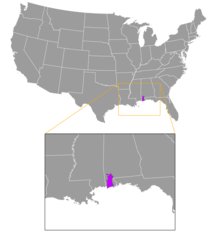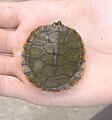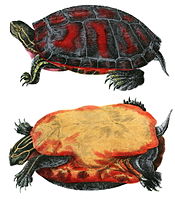Alabama red-bellied cooter
| Alabama red-bellied cooter | |
|---|---|

| |
| This turtle was sitting on the bank of Mobile Bay. | |
| Scientific classification | |
| Domain: | Eukaryota |
| Kingdom: | Animalia |
| Phylum: | Chordata |
| Class: | Reptilia |
| Order: | Testudines |
| Suborder: | Cryptodira |
| Superfamily: | Testudinoidea |
| Family: | Emydidae |
| Genus: | Pseudemys |
| Species: | P. alabamensis
|
| Binomial name | |
| Pseudemys alabamensis | |

| |
| Alabama red-bellied cooter range[3] | |
| Synonyms[4] | |
| |
The Alabama red-bellied cooter (Pseudemys alabamensis) or Alabama red-bellied turtle, is native to Alabama.[1][2] It belongs to the turtle family Emydidae, the pond turtles. It is the official reptile of the state of Alabama.[5]
Life history
[edit]The red-belly inhabits the fresh to brackish waters of the Mobile-Tensaw River Delta in Mobile and Baldwin counties.[2] It feeds on aquatic vegetation[6] and can be found sunning itself on logs. Nesting of the red-bellied turtle occurs from May through July. Female turtles lay their eggs on dry land, digging nests in sandy soil, where 4 to 9 eggs are laid. Hatchlings usually emerge during the summer. When the turtles nest in late July, hatchlings may overwinter in the nest and emerge the following spring.[citation needed]
A mature female can be 14 inches (360 mm), while a mature male can be 12 inches (300 mm).[6]
Location
[edit]As of June 2009 the turtle has been seen in the central part of Alabama, in the Elmore County region.[citation needed]
This turtle has also been found in south-eastern Mississippi,[7] in Harrison and Jackson counties.[6] It may also exist in northwest Florida.[2]
Protection
[edit]In 2007, a 3.4-mile (5.5 km) chain-link fence was constructed along part of the US 98 causeway (Battleship Parkway) that separates the Mobile-Tensaw delta from Mobile Bay.[8] Hatchling deaths dropped 80% from 2007 to 2008.[citation needed]
Gallery
[edit]-
Hatchling
-
Hatchling, plastron
-
Hatchling, carapace view
References
[edit]- ^ a b c Rhodin, Anders G.J.; van Dijk, Peter Paul; Iverson, John B.; Shaffer, H. Bradley; Roger, Bour (31 December 2011). "Turtles of the world, 2011 update: Annotated checklist of taxonomy, synonymy, distribution and conservation status" (PDF). Chelonian Research Monographs. 5: 000.181. Archived from the original (PDF) on 31 January 2012.
- ^ a b c d Tortoise & Freshwater Turtle Specialist Group (2016) [errata version of 1996 assessment]. "Pseudemys alabamensis". IUCN Red List of Threatened Species. 1996: e.T18458A97296493. doi:10.2305/IUCN.UK.1996.RLTS.T18458A8295960.en. Retrieved 25 July 2024. Listed as Endangered (EN B1+2c v2.3)
- ^ U.S. Geological Survey (2017). "Alabama Red-bellied Cooter (Pseudemys alabamensis) rARBCx_CONUS_2001v1 Range Map". Gap Analysis Project. doi:10.5066/F7Z31XTN.
- ^ Fritz Uwe; Peter Havaš (2007). "Checklist of Chelonians of the World". Vertebrate Zoology. 57 (2): 192. doi:10.3897/vz.57.e30895. S2CID 87809001.
- ^ "Official Alabama Reptile". Alabama Emblems, Symbols and Honors. Alabama Department of Archives & History. 12 July 2001. Archived from the original on 25 January 2008. Retrieved 19 March 2007.
- ^ a b c "Alabama – Great Days Outdoors Magazine Fishing, Hunting – Dedicated to Sportsmen and Their Families". Archived from the original on 16 April 2014. Retrieved 7 October 2018.
- ^ Southern Wonder: Alabama's Surprising Biodiversity by R. Scot Duncan, University of Alabama Press, 2013, page 367, ISBN 9780817357504
- ^ "Turtle protectors on the Causeway – BaldwinReport.com". baldwinreport.com. Archived from the original on 16 April 2014.
External links
[edit]- Save the Alabama Red-bellied turtle—Alabama red-bellied turtle alliance





